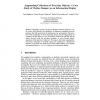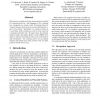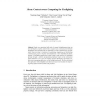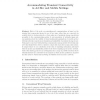PERVASIVE
2004
Springer
14 years 5 months ago
2004
Springer
Though the common conception of human-computer interfaces is one of screens and keyboards, the emergence of ubiquitous computing envisions interfaces that will spread from the desk...
PERVASIVE
2004
Springer
14 years 5 months ago
2004
Springer
Most gesture recognition systems analyze gestures intended for communication (e.g. sign language) or for command (e.g. navigation in a virtual world). We attempt instead to recogn...
PERVASIVE
2004
Springer
2004
Springer
"Are You with Me?" - Using Accelerometers to Determine If Two Devices Are Carried by the Same Person
14 years 5 months ago
As the proliferation of pervasive and ubiquitous computing devices continues, users will carry more devices. Without the ability for these devices to unobtrusively interact with on...
PERVASIVE
2004
Springer
14 years 5 months ago
2004
Springer
Abstract. Location-awareness is useful for mobile and pervasive computing. We present a novel adaptive framework for recognizing personally important locations in cellular networks...
PERVASIVE
2004
Springer
14 years 5 months ago
2004
Springer
PERVASIVE
2004
Springer
14 years 5 months ago
2004
Springer
PERVASIVE
2004
Springer
14 years 5 months ago
2004
Springer
Based on an extensive field study of current firefighting practices, we have developed a system called Siren to support tacit communication between firefighters with multiple level...
PERVASIVE
2004
Springer
14 years 5 months ago
2004
Springer
Abstract. Many work environments can benefit from integrated computing devices to provide information to users, record users’ actions, and prompt users about the next steps to t...
PERVASIVE
2004
Springer
14 years 5 months ago
2004
Springer
In an effort to support the development of context-aware applications that use archived sensor data, we introduce the concept of the Context Cube based on techniques of data wareho...
PERVASIVE
2004
Springer
14 years 5 months ago
2004
Springer
Much of the work on networking and communications is based on the premise that components interact in one of two ways: either they are connected via a stable wired or wireless netw...




